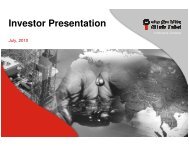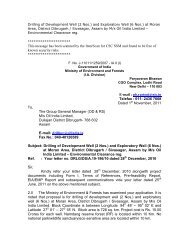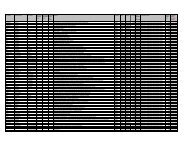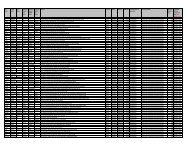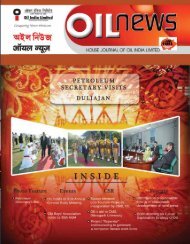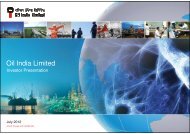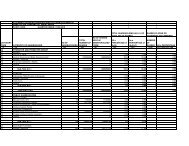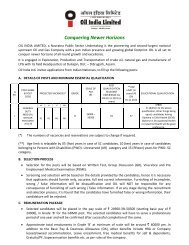Vol. 35 No. 8. May - Jun 2006 - Oil India Limited
Vol. 35 No. 8. May - Jun 2006 - Oil India Limited
Vol. 35 No. 8. May - Jun 2006 - Oil India Limited
You also want an ePaper? Increase the reach of your titles
YUMPU automatically turns print PDFs into web optimized ePapers that Google loves.
Technology<br />
8<br />
LEAN BURN TECHNOLOGY GAS ENGINE GENERATING SETS<br />
All around the globe unmet demand for electric power<br />
is making front page news. At one end, power<br />
producers are struggling to increase capacity,<br />
while on the other, industrial customers are becoming<br />
familiar with terms like "base-load", "power grid shortfall"<br />
and "rolling blackouts". Even power users who haven't<br />
experienced interruptions in service are facing problems<br />
such as escalating costs and uncertainties. And if meeting<br />
growing power demands weren't a big enough problem,<br />
today's power producers also need to cope with myriad<br />
contradictory forces such as aging infrastructure, regulatory<br />
issues, local and government environmental concerns etc.<br />
Air quality continues to be the concern that is increasingly<br />
putting pressure to produce electricity from cleaner<br />
sources. A major shift is the expanded of natural gas<br />
powered generation in preference to additional use of oil or<br />
coal powered electrical plants. Today, industries all over<br />
the globe wish to partake in the new concept of E-revolutiona<br />
revolution to fuel the economy and business in an<br />
economical and environment friendly way.<br />
Certainly the solution to all these issues is complex and<br />
multifaceted. The addition of gas powered reciprocating<br />
engine load generators to the generation mix is one solution<br />
to capacity shortfall and is a solution that is readily available,<br />
flexible, affordable, clean and reliable. Internal combustion<br />
engine powered generator sets fueled by natural gas are<br />
commanding more attention these days as interest grows<br />
in on-site power production equipment that is both efficient<br />
and environmentally friendly - in fact they shall play a major<br />
role in the future of distributed energy.<br />
The power generation from natural gas is based on two<br />
basic technologies - through turbines and through internal<br />
combustion engines. The effective use of turbines is seen<br />
in those industries which can use the exhaust gas heat<br />
efficiently, use high pressure fuel and operate at steady<br />
state loads. Turbines are however at disadvantage when<br />
the ambient temperatures are high, waste heat applications<br />
or waste heat uses are nil or very nominal and the loads<br />
are of fluctuating nature. Also the electrical efficiency of<br />
turbines, which are in the range of 18-32%, some time do<br />
not permit end users to operate them cost effectively as a<br />
substitute for grid power.<br />
For the industries looking for alternative power in lieu of<br />
grid supply, with nil or nominal waste heat applications,<br />
reciprocating engines operating on natural gas are the best<br />
solution. Reciprocating engines built with state-of-the art<br />
technology are available today, having with high fuel<br />
conversion ratio capable of obtaining system efficiency of<br />
around 40%. With full waste heat recovery the system<br />
efficiencies of more than 85% can be achieved without<br />
sacrificing the basic need of low cost power. Consequently,<br />
in the scenario of distributed power,<br />
internal combustion engines are drawing<br />
more attention in on-site power<br />
generation which is both efficient and<br />
environmentally friendly.<br />
Designing a clean and efficient engine is<br />
no easy task particularly when<br />
Partha Dutta<br />
adjustments to one variable often create<br />
undesired outcomes elsewhere. The key to a successful<br />
design is finding the optimum balance between high<br />
efficiency and low emissions. The most abundant and least<br />
expensive energy source, natural gas , is proving to be<br />
ideal for achieving a nearly perfect balance. In response to<br />
this interest, manufacturers have introduced natural gas<br />
engine-powered generator sets that feature new "lean-burn"<br />
technology.<br />
Goals have been set to develop more efficient and costeffective<br />
lean-burn gas engines within the next five to seven<br />
years which provide<br />
1. fuel-to-electricity conversion efficiency of at least<br />
50% (almost 30% higher than what's currently<br />
available)<br />
2. NOx emissions of 0.1 g/bhp/hr. (a 95% reduction,<br />
which still will need after treatment to meet tough<br />
air-quality standards)<br />
3. Significant reduction in maintenance costs.<br />
The program mentioned above called Advanced<br />
Reciprocating Energy Systems (ARES), so far has the<br />
support of the major engine manufacturers working in<br />
concert with the national laboratories and selected<br />
universities in the US , to expand the use of reciprocating<br />
engines for distributed-generation (DG) applications. It was<br />
launched in September 2001 and will proceed over three<br />
phases with research on advanced materials, fuel and air<br />
handling systems, advanced ignition and combustion<br />
systems, catalysts, and lubricants. Phase I was scheduled<br />
for completion during 2004-2005, while the deadline for final<br />
Phase III is 2009-2010. Cummins Power Generation,<br />
Caterpillar Inc., and Waukesha Engine Dresser Inc. have<br />
received Phase I grants and are "following individual research<br />
paths" and have already introduced engines based on" lean<br />
burn" concept.<br />
THE " LEAN BURN " WAY<br />
When a typical internal combustion engine runs, it burns<br />
fuel and air. The heat of combustion turns the nitrogen in<br />
that air into nitrogen oxides. These oxides are the precursors<br />
to what we call urban smog . It is thus understandable that<br />
engines would run much cleaner if they could run leaner,<br />
in other words, use less fuel and more air.



